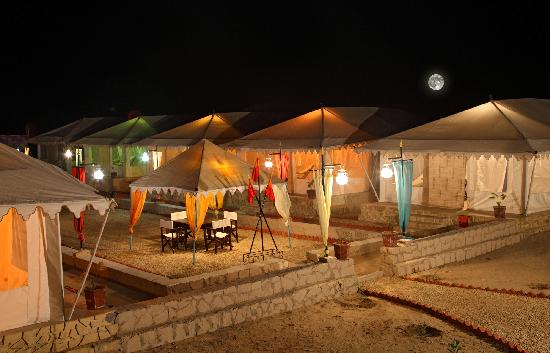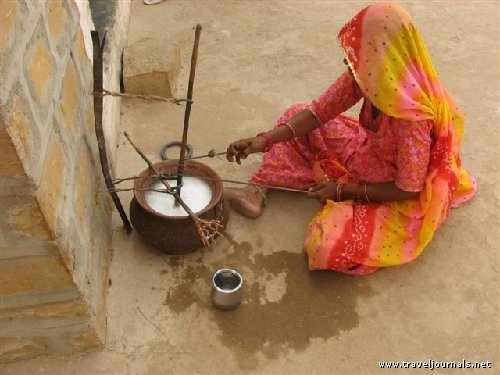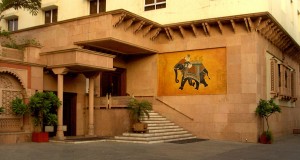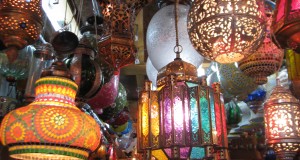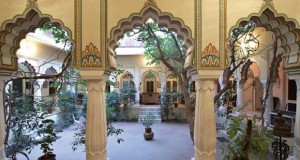Review Overview
2
Summary : Khuri lies in the heart of the Great Indian Desert, 40 km (25 miles) south-west of Jaisalmer.
Khuri lies in the heart of the Great Indian Desert, 40 km (25 miles) south-west of Jaisalmer. It is the central village of about 100 smaller settlements ruled by the Rajpu Sodhas, a ‘fire’ caste who hail their origin from a mythological hero called Parma (one of the founders of the Rajput clans, who sprang from the holy flame at Achalgat, Mount Abu).
The Sodha family have ruled Khuri for some 400 years. There are about 2000 inhabitants, though about half of these are wandering nomads who travel far afield in search of water and fodder for their cattle. Noble, dignified Father Singh is the head man, but the real power behind the throne is ‘Mama’ Singh—a large, charis , matic lady with a heart of gold and a real talent for cooking. Her two charmini well-educated sons—Bhagwan Singh and Tane Singh Sodha—are both perfect. gentlemen, and take responsibility for looking after tourists. The service here is quit incredible: if they like you, you are instantly adopted into the family and simpl nothing is too good for you. People they don’t like are given a meal, then politely but firmly sent back to Jaisalmer on the next bus. As Tane Singh comments: ‘Here in Khuri we are not out to exploit tourists—we want them to see the real away of the desert. And we are determined to keep our traditional customs and values. even if this means living somewhat in the past with simple means and few luxuries Visitors who do not respect our culture, or who press business on us, we turn awa ‘ For the past 12 or so years, Western tourists have made the arduous trip out toe Jaisalmer with one main objective—to do the big camel-trek into the Great Thar Desert. But the best part of the desert, the rolling sand-dunes, don’t actually appear till some 40 km (25 miles) out of Jaisalmer.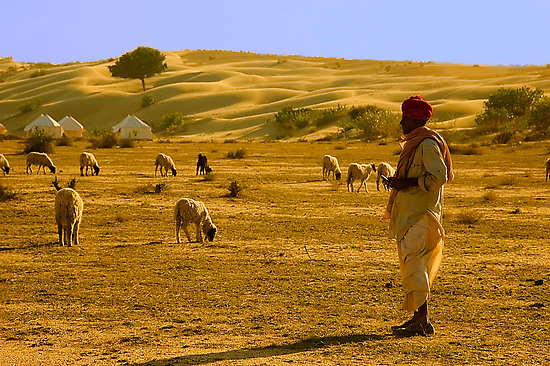
To see the dunes, you’ll have to go to Khuri. Jaisalmer hoteliers know this, and do everything in their power to stop travellers going there. They tell them awful fibs like ‘Khuri is restricted area’, or ‘Khuri is in Pakistan’, or even ‘Khuri is out-of-bounds army post’. If this fails, they put a boycott on travellers returning from Khuri, and refuse to put them up in Jaisalmer. The best policy is to tell no one you’re coming, here, and (on your return) to tell no one where you’ve been. Come to Khuri for an authentic desert experience. As one traveller wrote: ‘When planning the culmination of your Rajasthan journey, try to find yourself here. Khuri is the gateway to the real Rajput people, folklore and customs. If you can, spend a week or so here, learn about the people, and become part of their extended family an d way of life. Here, you can really become one with the desert and its tribes.’ ‘he best time to visit is between September and February, when the desert is most cool and pleasant. The Sodhas run camel-safaris from October to March. Long treks of between 12 and 15 days—for enthusiasts who want a ‘complete’ experience of the desert—are really only practical from November to January. Bhagwan Singh runs a npecial 2-week camel-safari to connect with the annual Cattle Fair (100 000 cattle, 200 000 people) at Tilwara. This event, which takes place at the end of March, is even bagger and more spectacular than the famous Camel Fair at Pushkar.
Important Note: At the time of going to press, in September 1992, there were reports I hat Khuri was to fall within the inner line, and so become out of bounds to tourists. Permits to visit the area may be given by the District Commissioner’s office in jaisalmer. Permits are also required to visit the National Park in addition to making prior arrangements with the park authorities in Jaisalmer.
A RRIVAL /DEPARTURE
Negotiate the line of a jeep for the 40-km (25-mile) drive, or take the mid-morning bus which takes about 1 1/2 hours. (Buses return at about 4.30 pm.)
Khuri is the place to come for a once-in-a-lifetime experience: a camel-trek across the white, rolling dunes of the Thar Desert. How long you stay is up to you. For maximum enjoyment, aim to spend at least 3 days here: one day to see the village, followed by a 2-day camel-trek. For those bothered by heat (and that applies to anybody coming here after end of March) a day excursion will be quite sufficient.
Khuri camel-treks are rather more expensive than Jaisalmer’s. Charges vary a lot, depending on whether or not Mama takes to you. After all, the best thing about Khuri Mtama’os cokinge—a wide range of traditional breads and vegetarian dishes, lots of it—and she doesn’t tolerate skimpy eaters. All meals, and endless pots of thirst-quenching cardamom tea, are included in the price. So is one of the small behive-shaped guest huts in the village. So are very mild-mannered, obedient camels and incredibly obliging camel-drivers. And—most important—so is the e helming hospitality of the villagers. A testimonial book of satisfied customers, the,’ Hirst thing you’re shown on arrival, speaks for itself.
Bhagwan Singh always meets the morning bus from Jaisalmer at Khuri. He escorts you to the reception building, pumps you with tea and hospitality, settles you in your but and sends Mama over to greet you. Then you get lunch—about 10 courses of it. I a ter, after a siesta, a tour is arranged for you round the village. This takes place round dusk, when the heat is down and the desert sky is at its most beautiful.
klhuri village is a charming, modest settlement of small mud-and-stone beehive dwellings and stone huts, many painted with Aztec-like patterns by the women, Interspersed with a few wicker cattle-pens. The tough old village elders squat or sit outside their huts, pounding flax for wool or spinning rough thread, while the younger men and boys pound straw and mud between the bricks of newly rising walls and huts. They are shy of visitors, but invariably friendly. Ask to be shown khuri’s small ‘shop’—you’ll need it to stock up on supplies for your morning trek. desert tribes are heavily into ‘guest-gifts’, and you will do well to buy in a good stocks of cigarettes, bidis, pens and sweets here. All these things are cheap, and godown well. So do small presents like English/American coins, and postcards of the Royal Family.
At sunset, climb to the roof of the hospitality/reception building and watch the evening sky turn deep, silky velvet-b lue, and the thin cloud tissue burn a vivid rose-pink before fading suddenly into darkness. Night falls very quickly, and there is no electricity, only oil-lamps. The evening is generally spent with Bhagwan Singh and his chums in the courtyard below, supping the desert ‘country wine’ and listening to the low, atmospheric women’s songs and village drums, as yet another marriage hut is ritually prepared for the bride and groom. Your bed is made up for you outside your hut, and you drift off to sleep under a glittering canopy of stars. In the morning, after a substantial breakfast, you are introduced to your camel and your driver. Before leaving, check your equipment and dress: you’ll need a flashlight (for sleeping out in the dunes), a good pair of sun-glasses (for desert glare), lots of camera film (photos are a great way of making friends in the villages) and as many oranges (best thirst-quenchers) as you can carry in from Jaisalmer. All food, water and bedding is provided for you, and a comfortable seat is made up on the camel Despite this, many people suffer aching thighs and backsides on trek, so make sure your seat has as much padding as possible. Strong, comfortable shoes are a must— and they need to be narrow to fit in the camel stirrups. Sandals are no good. As for clothing, wear long trousers/skirts and long-sleeved shirts—not only because the Rajputs are a very modest people, but also because any exposed flesh is burnt red-raw after a few hours in the intense desert sun. Men should consider two pairs of underpants; women will certainly need bras. Both sexes should bring some sort of protective headwear (brimmed hats are best). An excellent alternative is a Jodhpur umbrella. Take the minimum of luggage on trek—leave your pack or bag with Mama Singh under lock and key.
lue, and the thin cloud tissue burn a vivid rose-pink before fading suddenly into darkness. Night falls very quickly, and there is no electricity, only oil-lamps. The evening is generally spent with Bhagwan Singh and his chums in the courtyard below, supping the desert ‘country wine’ and listening to the low, atmospheric women’s songs and village drums, as yet another marriage hut is ritually prepared for the bride and groom. Your bed is made up for you outside your hut, and you drift off to sleep under a glittering canopy of stars. In the morning, after a substantial breakfast, you are introduced to your camel and your driver. Before leaving, check your equipment and dress: you’ll need a flashlight (for sleeping out in the dunes), a good pair of sun-glasses (for desert glare), lots of camera film (photos are a great way of making friends in the villages) and as many oranges (best thirst-quenchers) as you can carry in from Jaisalmer. All food, water and bedding is provided for you, and a comfortable seat is made up on the camel Despite this, many people suffer aching thighs and backsides on trek, so make sure your seat has as much padding as possible. Strong, comfortable shoes are a must— and they need to be narrow to fit in the camel stirrups. Sandals are no good. As for clothing, wear long trousers/skirts and long-sleeved shirts—not only because the Rajputs are a very modest people, but also because any exposed flesh is burnt red-raw after a few hours in the intense desert sun. Men should consider two pairs of underpants; women will certainly need bras. Both sexes should bring some sort of protective headwear (brimmed hats are best). An excellent alternative is a Jodhpur umbrella. Take the minimum of luggage on trek—leave your pack or bag with Mama Singh under lock and key.
Every camel comes complete with an experienced driver, who sits behind you and anticipates your every need. He is often a burnt-black, brightly turbaned character who grins a lot and speaks better camel than English. Many camel-drivers while away the hours singing plaintive desert songs (which is pleasant) and giving their foreign guests regular body-massages, both on and off the camel. Whatever you do, don’t complain of an aching rear. This will only get you hurled face-down on the sands and pummelled rudely on the buttocks until you are screaming for mercy.

Camel-safaris from Khuri start off about 8 am, and you ride for about 4 hour (stopping at the most attractive dunes) until the heat becomes too intense, roun noon. Lunch, and a long siesta, is spent at one of the nearby villages. Then, around 4 pm, you set off again. By now, you’re probably used to the peculiar rocking, rollin sensation of camel-riding. Your kidneys have had a jolly good shuffle, and if the long siesta hasn’t calmed you down, then the slow, soothing desert pace of life soon will. The vista is a silent, empty yellow-white wasteland of rolling sands, interspersed with bare rock and desolate scrub. From time to time, you may see a chinkara or Indian gazelle springing across the flatlands, or a flock of bright-plumed peacocks out for a stroll, or the occasional mongoose, fox, desert rat or the Great Indian Bustard, but otherwise there is absolutely nothing out there. A few hours of this, and the mind switches off and begins to play tricks. The most common mirage is of a five-star hotel with a refrigerated swimming-pool and ice-cold beers. Sudden electric storms, dust storms, sand storms and rain storms tend to break the spell. So does the periodic emergence from the bleached-white desert of small local villages. They all look identical, and most of them are keen to trade or barter presents. The best thing to ask for is a bottle of Black Panther Triple X Rum (army canteen issue), which is the perfect way of ending a hard day’s trek.
Sleeping out on the dunes is a magical experience. The night sky is crystal-clear, them desert goes quite silent, and the bunched cacti and brush lie in stark relief against moonscape of the marble-smooth sands, giving the sinister aspect of giant surreal spiders frozen to the desert floor.
The sunrise, like the sunset, is another desert spectacle. It heralds the arrival of a huge breakfast, cooked by the  drivers, and a glorious pot of steaming cardamom tea. Three more hours on the camel, and you’re back in Khuri—to be met by Mama with a special lunch, and treated to as many cold showers and liquid refreshments as you can handle. The Sodha family crowd around to make their farewells, and see you safely onto the 4.30 pm bus out to Jaisalmer. You will remember their hospitality for years to come.
drivers, and a glorious pot of steaming cardamom tea. Three more hours on the camel, and you’re back in Khuri—to be met by Mama with a special lunch, and treated to as many cold showers and liquid refreshments as you can handle. The Sodha family crowd around to make their farewells, and see you safely onto the 4.30 pm bus out to Jaisalmer. You will remember their hospitality for years to come.
SHOPPING Khuri has no tourist handicrafts business, and that’s the way the Sodha family wish to !keep it. There is a thriving cottage industry of pottery, blanket: .amel rugs and embroidery, but all these things are made by the villagers either for their own use or for barter with neighbouring villagers. Only if you supply your own materials your own camel, sheep’s or goat’s wool from Jaisalmer) will they consider taking orders tor carpets, rugs or blankets. Tane Singh Sodha believes: ‘Once greed, money and trade comes into a village, it turns the people bad. We don’t want that.’

